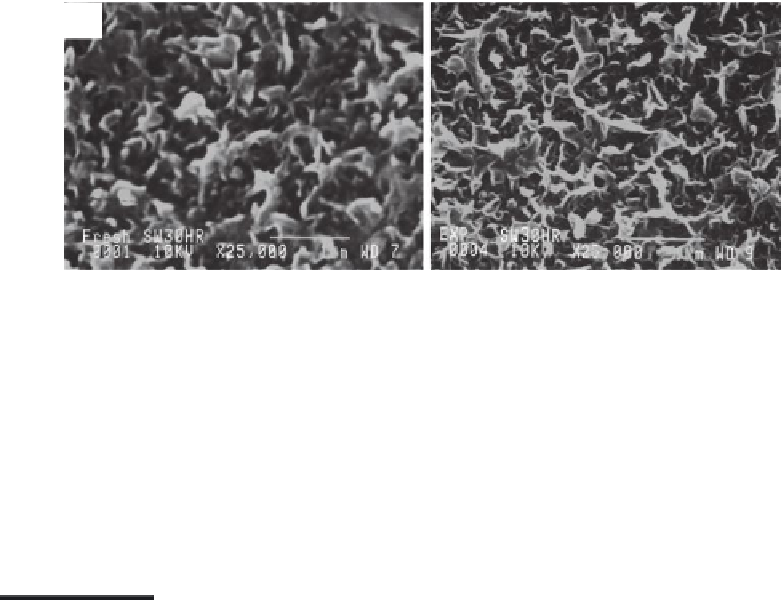Environmental Engineering Reference
In-Depth Information
(a)
(b)
FIGURE 27.12
(a) Unexposed SW30HR membrane. (b) SW30HR membrane exposed to 15% wt. Hydroluoric acid (HF) for
11 days. (From Mukherjee, D., A. Kulkarni, and W.N. Gill,
Journal of Membrane Science
, 97, 231, 1994.)
along the membrane surface. This system achieves sustainable luxes of 22-27 l/m
2
h for
40%-50% recovery rates. From the patent report, a 380 V, 50 Hz power supply is called out
to run the electric ield on the coils, which is reported to run at a steady 2 A, consuming
760 W of power [61].
27.3 Emerging Water Desalination Technologies
As discussed above, a variety of methods and processes already exist to desalinate water
[62-65]. However, with water, owing to high demand and increased energy consumption
concerns, there has been a renewed interest in developing new technological platforms
that can provide the solutions for next-generation water desalination needs [1,66]. For
example, increasing energy demands have led to development of technologies for hydrau-
lic fracturing or “fracking.” The low-back water (which can be 15%-30% of the total injec-
tion volume for a well being drilled with several million gallons needed) has signiicantly
different salinity compared with seawater or other saline water sources. TDS can exceed
100,000 mg/l with the potential to reach nearly 300,000 mg/l. In addition, chlorides can be
very high, reaching nearly 100,000 mg/l. Furthermore, low-back water from fracking con-
tains high particulates, including silica. Other problematic constituents include barium,
calcium, strontium, and sulfates. Shallow or thin shales (e.g., the Marcellus formation in
the United States) can also contain radioactive species. Therefore, desalinating and puri-
fying low-back water will likely require a shift in how existing technology can be used
leading to use of several new or advanced methods for water treatment.
As discussed above, membrane processes are becoming increasingly popular for water
desalination. The minimum thermodynamic energy needed for desalination assumes
complete energy recovery, minimal polarization impedance, no membrane viscous and
fouling losses, and no energy losses for membrane cleaning. Furthermore, these thermody-
namic estimates assume that the source water stream comprises only of salt and water; that
is, the energy required for all preiltration steps for removal of pathogens, organic waste,
colloids, etc., is not included. Two main approaches are being targeted for developing new
water desalination methods. First is to improve existing technologies by integration with


